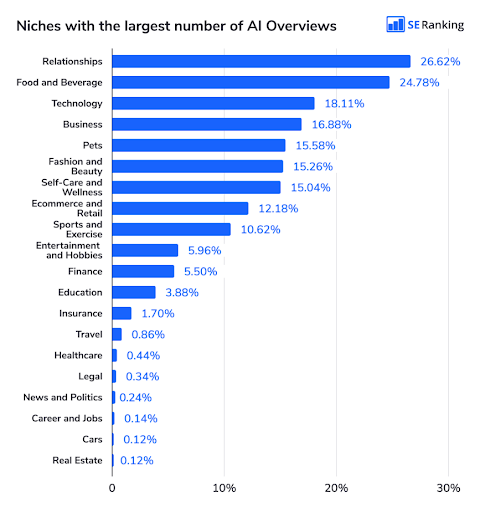Google has always evolved, improving algorithms and introducing new features. However, many fear the new AI overview feature might change SEO, and not in a good way. Are these fears substantiated? How does AI overview (AIO) change the web? How can SEOs prepare for the impact and create a Google AIO strategy?
5 Ways to Prepare Your Website for AI Overviews
- Adjust your keyword research with qualitative analysis.
- Focus on delivering middle- and bottom-funnel content.
- Structure content for feature snippets and knowledge graphs.
- Build your brand reputation.
- Optimize your content and website to rank in the top 10 of the search engine results page (SERP).
We’ll explore those questions and more in this article.
How Does Google’s AI Overview Impact SEO?
Google’s latest search feature is known under two names. The official name right now is AI overview (AIO), but it used to be called search generative experience (SGE). Many people still refer to it as such, but we’ll use AIO in this article.
An AI overview occurs when you google specific keywords on Google, yielding an AI-generated summary of the topic.
Google’s AI analyzes several pages related to a given keyword and then produces the overview text and links them in the results.
After viewing the overview text, the user can continue the AI-generated search experience by asking it a follow-up question, following one of the suggested source links or scrolling down to see the organic results.
AI overview adds three more options for Google users, all leading them further from viewing the organic search results.
What exactly does this mean for SEO and the future of search? The truth is, it’s too early to tell.
The latest SE Ranking study on Google’s AI Overview shows drastic changes compared to an earlier study done in January 2024.
- The “Generate overview” button is gone from the search. Now, Google searches either generate AI overview or don’t, with no in-between option.
- The number of keywords that trigger AI overview is down significantly, from 64 percent to 8.71 percent.
- AIO is now accompanied by more ads, 87 percent of searches compared to 73 percent.
- The average number of sources linked in SGE is down from eight to four.
It’s safe to say that AI overview remains an experimental feature and is likely to change in the future, just like any other Google practice.
For instance, a huge drop to only 8 percent of keywords triggering AIO might be good news for SEOs, as they won’t have to fear drastic changes in how search works. Or it could be a temporary solution to improve Google’s AI before we see a resurgence of the number of keywords with AIO.
We can, however, look at the general trends in Google AI overview and make conclusions on what areas SEOs should focus on to succeed as this search feature becomes more prominent. SE Ranking study that covered 100,000 keywords provides the following:
- 90 percent of searches don’t have AI overview.
- A typical AIO is over 4,000 characters long, most of which is hidden under a drop-down.
- Most SGE results link to one source, which increases to four-to-seven sources after clicking the show more button.
- YMYL topics have more sources linked in AIO, both pre and post-click.
- Almost 85 percent of AIOs link to at least one organic search result from the top 10, and 15 percent have no overlap in links.
- AI overview links to authoritative domains like Wikipedia or Forbes and social media content platforms, like LinkedIn and YouTube.
- The more words in a search query, the more likely it will trigger an AIO. Long-tail queries formed as questions will trigger it the most.
- The less search volume a keyword has, the more likely you’ll see an AIO.
- Lower cost-per-click also triggers more AIO, with keywords under $0.5 ending in 54 percent of AIO.
- In 49 percent of AI Overview results, Google ads appear above them.
- Some niches are more likely to trigger an AI overview than others. Relationships and food and beverage niches both trigger AIO in around 25 percent of searches, and business and tech hover around 17 percent.
It seems Google is putting AI results in niches that don’t require big financial decisions.

What does this mean for Google AIO strategy in SEO? We can draw a couple of conclusions.
- Few keywords will trigger AI overview, so you’ll have to monitor SERP before you act.
- Short, high-competition keywords are likely to be the least affected.
- Many AI overviews will feature at least one of the top 10 results or another authoritative site. Since users might think these sources are authoritative, it opens another field of search engine optimization.
- AI overviews will cover the basics of informational searches they appear on, so your content has to dive deeper into the topic.
Let’s explore how you can enhance your SEO efforts with AIO.
Preparing Your Website for Google AI Overviews
Google AI Overviews impact all areas of SEO. Let’s unpack important aspects one by one.
1. Keyword Research
The first change AIO brings to modern SEO is making keyword research harder, making you control another search feature and monitor what links it has.
Right now, a couple of SEO tools have a beta version of an AI overview tracker, and the quality of the tools will progress alongside an AI overview.
You do need to perform qualitative analyses as well and figure out where the AI overview took the information from and linked back to the pages that it did.
The exact reason might be different from keyword to keyword, so that would be hard to analyze with a tool.
A few more things that might change in keyword research are that ranking for generic keywords can become harder, and zero-click searches will increase even more.
Since AIO doesn’t trigger as much for high-competition short keywords, which are mostly transactional or commercial in nature, companies will focus their efforts on these keywords, leading to more competition.
AI overview will also eliminate the need to click on a link in organic results if a user is looking for surface-level information. This might not be as bad as it sounds, as people who are interested in the details will still click on your page and might also convert.
2. Content
The fear many SEOs have now is that AI overview will completely overtake informational keywords and kill blogging to gain traffic.
With AIO answering basic questions shortly, it will increase the number of zero-click searches and may result in less traffic to your informational pages. But it won’t make blog content obsolete.
The two main reasons:
- AI still needs to take information from somewhere. It will link to the best results, providing SEOs with an opportunity to gain traffic.
- Many users are interested in more than a short answer and will still click on your page in organic search.
You’ll have to adapt your content SEO strategy, though.
Focus on middle and bottom-funnel content. Easier, top-of-the-funnel content can be answered by AI. Middle and bottom-funnel pieces will receive more traffic simply because the topics can’t be contained in a 4,000-character AI summary.
Improve your topical authority. Google needs to understand that your site has expert authors and has covered a specific topic substantially, which will make getting a link from AIO more likely.
Invest in quality content. This tip has been the cornerstone of SEO for the last decade but will become even more important now. AIO provides the basic answers, and hundreds of sites produce basic AI-generated content.
A good Google AI strategy would be to stand out by creating user-first content with unique insights. This can improve branding and sales even more.
3. Structuring Content for Featured Snippets and Knowledge Graphs
When AI overview and featured snippet appear together, their sources match in 62 percent of searches, according to the SE Ranking AIO study. This means Google AIO marketing includes optimizing for featured snippets and other Google search features like knowledge panels to improve your chances of having your link in the AIO.
Even if your link won’t appear there, your page will be more visible on SERP, thanks to appearing in that snippet.
To improve your chances of appearing in the featured snippet, try:
- Using formats like “What is a keyword” in the heading and “A keyword is” in the body of the text for definition searches. Try to explain it in a few sentences.
- Using bulleted and numbered lists and tables with proper HTML tags.
- Doing small iterations until you succeed.
To get a knowledge panel, create and verify key data points like:
- Google Business Profile
- Wikipedia
- LinkedIn and other social media channels
- Crunchbase and similar sites
Another Google AI strategy would be to add a Schema markup to your main page. Always check your structured data with a tool to make sure it is done correctly.
4. Brand Reputation Management and Digital PR
Authority in the eyes of Google might be the deciding factor in getting AIO mentions. Your brand’s online reputation is also going to be crucial if a user sees an AI Overview of your brand.
Google will mostly look at third-party mentions of your brand, so focus on other platforms to build up your brand reputation.
- Receive mentions from reputable websites like news sites and industry blogs.
- Manage negative reviews on review platforms.
- Engage in discussions on online forums like Reddit and Quora.
- Engage with customers on social media.
The first two are the most important to influence how Google sees your brand image.
5. Improve SEO rankings
As the SE Ranking study shows, most AI Overview features cite pages from the top 10 of SERP as sources. So, ranking high is one of the components of success when it comes to AIO.
Focus on the SEO basics:
- Proper keyword research, keyword clustering and optimization.
- Technical optimization, especially practices that influence core web vitals.
- Off-page optimization focused on gaining mentions from authoritative websites.
- UX of core pages. This can signal to Google your page is well-liked by users.
Monitor SEO performance and adjust your strategy to rank in the top 10 on SERP that has AI Overview to raise the likeliness of being featured in the sources.
Forming a Google AIO strategy is a hard task because the way AI overview works is likely to change. Monitor which of the keywords you target have AI overview in SERP, work on making your content unique and informative, improve your brand reputation online and optimize your site for featured snippets. This will mitigate the problem of zero-click searches and give you a good chance of getting a mention in the AIO.





